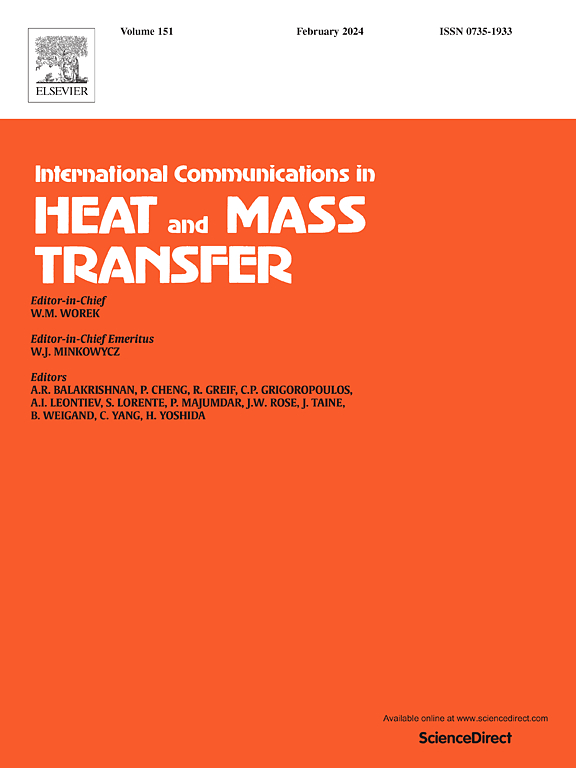Melting and solidification processes within the Trombe wall enhanced by a paraffin layer with nanoparticles
IF 6.4
2区 工程技术
Q1 MECHANICS
International Communications in Heat and Mass Transfer
Pub Date : 2025-03-27
DOI:10.1016/j.icheatmasstransfer.2025.108903
引用次数: 0
Abstract
This work focuses on the numerical simulation of a new Trombe wall design, incorporating a paraffin zone and fins. The simulations encompass both melting and solidification processes in the presence and absence of sunlight, comparing the performance with a classic Trombe wall. Time-dependent boundary conditions are applied to surfaces, while the paraffin is enhanced with nanoparticles for improved conduction. The Surface-to-Surface radiation model (S2S) and RNG![]() K
K![]() ε for turbulent airflow are employed. Code verification for the classic Trombe wall and melting process demonstrated good agreement. Results revealed the temperature variations within the room and different layers, along with the distribution of liquid fraction. The liquid fraction increases and then decreases during each day, with the finless case displaying a higher value. The introduction of fins enhances the liquid fraction, and this difference amplifies over time. Incorporating a paraffin layer with a constant volume, increases temperature fluctuation by 8.06 %. However, the implementation of Y-shaped fins reduces temperature fluctuation by 28.97 % compared to the traditional unit, indicating a 29 % enhancement in thermal comfort with the proposed design.
ε for turbulent airflow are employed. Code verification for the classic Trombe wall and melting process demonstrated good agreement. Results revealed the temperature variations within the room and different layers, along with the distribution of liquid fraction. The liquid fraction increases and then decreases during each day, with the finless case displaying a higher value. The introduction of fins enhances the liquid fraction, and this difference amplifies over time. Incorporating a paraffin layer with a constant volume, increases temperature fluctuation by 8.06 %. However, the implementation of Y-shaped fins reduces temperature fluctuation by 28.97 % compared to the traditional unit, indicating a 29 % enhancement in thermal comfort with the proposed design.
求助全文
约1分钟内获得全文
求助全文
来源期刊
CiteScore
11.00
自引率
10.00%
发文量
648
审稿时长
32 days
期刊介绍:
International Communications in Heat and Mass Transfer serves as a world forum for the rapid dissemination of new ideas, new measurement techniques, preliminary findings of ongoing investigations, discussions, and criticisms in the field of heat and mass transfer. Two types of manuscript will be considered for publication: communications (short reports of new work or discussions of work which has already been published) and summaries (abstracts of reports, theses or manuscripts which are too long for publication in full). Together with its companion publication, International Journal of Heat and Mass Transfer, with which it shares the same Board of Editors, this journal is read by research workers and engineers throughout the world.

 求助内容:
求助内容: 应助结果提醒方式:
应助结果提醒方式:


